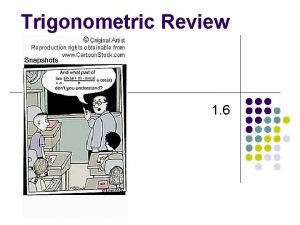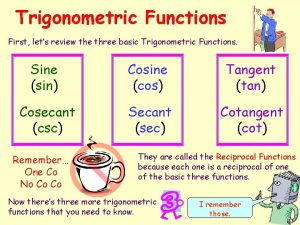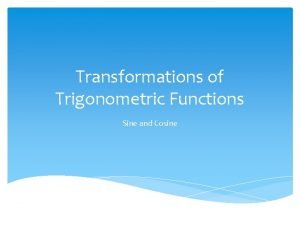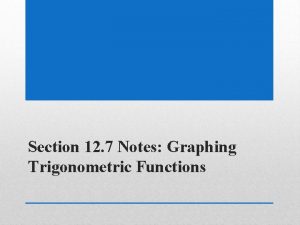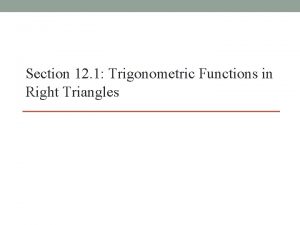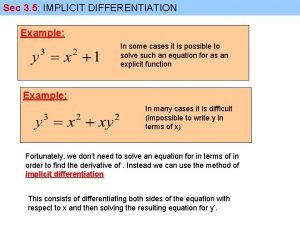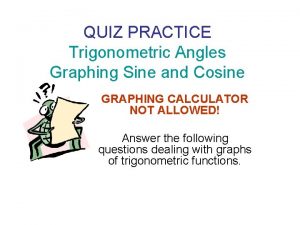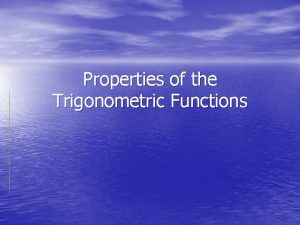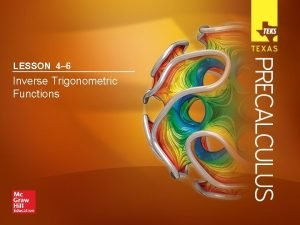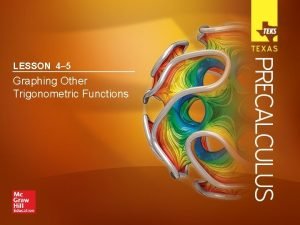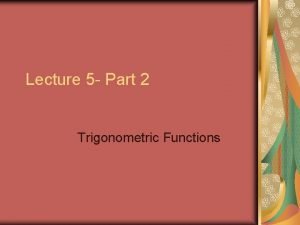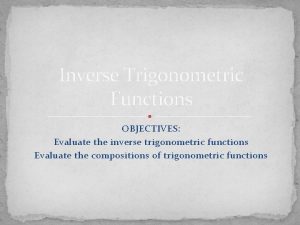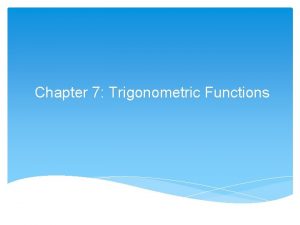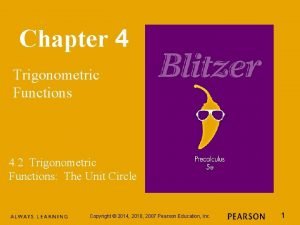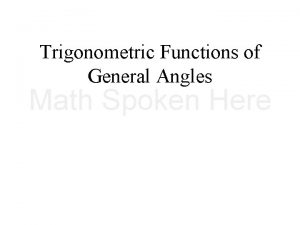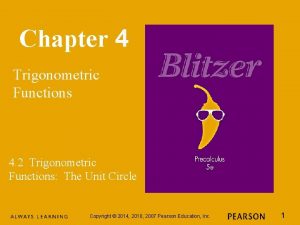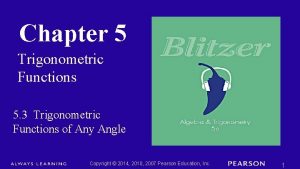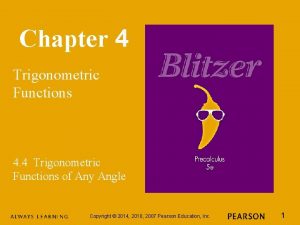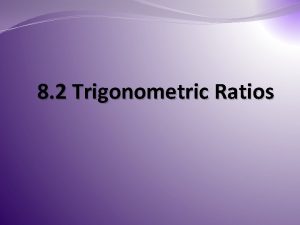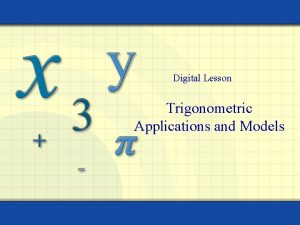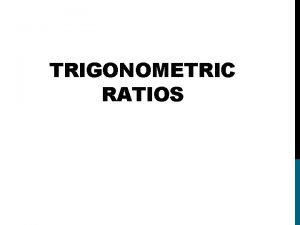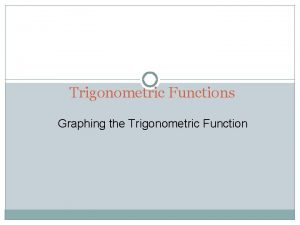2 4 Applications of Trigonometric Functions Copyright 2018


















- Slides: 18

2. 4 Applications of Trigonometric Functions Copyright © 2018, 2014, 2010 Pearson Education, Inc. All Rights Reserved Slide - 1

Objectives • Solve a right triangle. • Solve problems involving bearings. • Model simple harmonic motion. Copyright © 2018, 2014, 2010 Pearson Education, Inc. All Rights Reserved Slide - 2

Solving Right Triangles Solving a right triangle means finding the missing lengths of its sides and the measurements of its angles. We will label right triangles so that side a is opposite angle A, side b is opposite angle B, and side c, the hypotenuse, is opposite right angle C. When solving a right triangle, we will use the sine, cosine, and tangent functions, rather than their reciprocals. Copyright © 2018, 2014, 2010 Pearson Education, Inc. All Rights Reserved Slide - 3

Example 1: Solving a Right Triangle Let A = 62. 7° and a = 8. 4. Solve the right triangle, rounding lengths to two decimal places. Solution: Copyright © 2018, 2014, 2010 Pearson Education, Inc. All Rights Reserved Slide - 4

Example 2: Finding a Side of a Right Triangle From a point on level ground 80 feet from the base of the Eiffel Tower, the angle of elevation is 85. 4°. Approximate the height of the Eiffel Tower to the nearest foot. Solution: The height of the Eiffel Tower is approximately 994 feet. Copyright © 2018, 2014, 2010 Pearson Education, Inc. All Rights Reserved Slide - 5

Example 3: Finding an Angle of a Right Triangle A guy wire is 13. 8 yards long and is attached from the ground to a pole 6. 7 yards above the ground. Find the angle, to the nearest tenth of a degree, that the wire makes with the ground. Solution: The wire makes an angle of approximately 29. 0° with the ground. Copyright © 2018, 2014, 2010 Pearson Education, Inc. All Rights Reserved Slide - 6

Trigonometry and Bearings (1 of 4) In navigation and surveying problems, the term bearing is used to specify the location of one point relative to another. The bearing from point O to point P is the acute angle, measured in degrees, between ray OP and a north-south line. The north-south line and the eastwest line intersect at right angles. Each bearing has three parts: a letter (N or S), the measure of an acute angle, and a letter (E or W). Copyright © 2018, 2014, 2010 Pearson Education, Inc. All Rights Reserved Slide - 7

Trigonometry and Bearings (2 of 4) If the acute angle is measured from the north side of the north-south line, then we write N first. Second, we write the measure of the acute angle. If the acute angle is measured on the east side of the north-south line, then we write E last. Copyright © 2018, 2014, 2010 Pearson Education, Inc. All Rights Reserved Slide - 8

Trigonometry and Bearings (3 of 4) If the acute angle is measured from the north side of the north-south line, then we write N first. Second, we write the measure of the acute angle. If the acute angle is measured on the west side of the north-south line, then we write W last. Copyright © 2018, 2014, 2010 Pearson Education, Inc. All Rights Reserved Slide - 9

Trigonometry and Bearings (4 of 4) If the acute angle is measured from the south side of the north-south line, then we write S first. Second, we write the measure of the acute angle. If the acute angle is measured on the east side of the north-south line, then we write E last. Copyright © 2018, 2014, 2010 Pearson Education, Inc. All Rights Reserved Slide - 10

Example 4: Understanding Bearings Use the figure to find each of the following: a. the bearing from O to D Point D is located to the south and to the east of the northsouth line. The bearing from O to D is S 25°E. b. the bearing from O to C Point C is located to the south and to the west of the north-south line. The bearing from O to C is S 15°W. Copyright © 2018, 2014, 2010 Pearson Education, Inc. All Rights Reserved Slide - 11

Simple Harmonic Motion An object that moves on a coordinate axis is in simple harmonic motion if its distance from the origin, d, at time t is given by either The motion has amplitude maximum displacement of the object from its rest position. The period of the motion is, where The period gives the time it takes for the motion to go through one complete cycle. In describing simple harmonic motion, the equation with the cosine function, is used if the object if the greatest distance from rest position, the origion, at t = 0. By contrast, the equation with the sine function, origion, at t = 0. is used if the object is at its rest position, the Copyright © 2018, 2014, 2010 Pearson Education, Inc. All Rights Reserved Slide - 12

Example 5: Finding an Equation for an Object in Simple Harmonic Motion (1 of 2) A ball on a spring is pulled 6 inches below its rest position and then released. The period for the motion is 4 seconds. Write the equation for the ball’s simple harmonic motion. Solution: When the ball is released (t = 0), the ball’s distance from its rest position is 6 inches down. Because it is down, d is negative. t = 0, d = − 6. The greatest distance from rest position occurs at t = 0. Thus, we will use the equation with the cosine function, Copyright © 2018, 2014, 2010 Pearson Education, Inc. All Rights Reserved Slide - 13

Example 5: Finding an Equation for an Object in Simple Harmonic Motion (2 of 2) Solution is the maximum displacement. Because the ball is initially below rest position, a = − 6. The value of can be found using the formula for the period. We have found that a = − 6 and The equation for the ball’s simple harmonic motion is Copyright © 2018, 2014, 2010 Pearson Education, Inc. All Rights Reserved Slide - 14

Frequency of an Object in Simple Harmonic Motion An object in simple harmonic motion given by has frequency f given by Equivalently, Copyright © 2018, 2014, 2010 Pearson Education, Inc. All Rights Reserved Slide - 15

Example 6: Analyzing Simple Harmonic Motion (1 of 3) An object moves in simple harmonic motion described by where t is measured in seconds and d in centimeters. Find the maximum displacement. Solution: The maximum displacement from the rest position is the amplitude. Because a = 12, the maximum displacement is 12 centimeters. Copyright © 2018, 2014, 2010 Pearson Education, Inc. All Rights Reserved Slide - 16

Example 6: Analyzing Simple Harmonic Motion (2 of 3) An object moves in simple harmonic motion described by where t is measured in seconds and d in centimeters. Find the frequency. Solution: The frequency is cycle per second. Copyright © 2018, 2014, 2010 Pearson Education, Inc. All Rights Reserved Slide - 17

Example 6: Analyzing Simple Harmonic Motion (3 of 3) An object moves in simple harmonic motion described by where t is measured in seconds and d in centimeters. Find the time required for one cycle. Solution: The time required for one cycle is the period. The time required for one cycle is 8 seconds. Copyright © 2018, 2014, 2010 Pearson Education, Inc. All Rights Reserved Slide - 18
 Copyright © 2018
Copyright © 2018 Copyright © 2018 all rights reserved
Copyright © 2018 all rights reserved Que letra continua m v t m j
Que letra continua m v t m j Trigonometry cofunction
Trigonometry cofunction Three basic trigonometric functions
Three basic trigonometric functions Sine cosine partner
Sine cosine partner Period of trigonometric functions
Period of trigonometric functions 12-7 graphing trigonometric functions answers
12-7 graphing trigonometric functions answers 12-1 trigonometric functions in right triangles
12-1 trigonometric functions in right triangles Differentiate trigonometric
Differentiate trigonometric 9-5 practice graphing trigonometric functions
9-5 practice graphing trigonometric functions Domain range of trig functions
Domain range of trig functions Trigonometric limit identities
Trigonometric limit identities 6 inverse trig functions
6 inverse trig functions Csc a
Csc a Parts of trigonometric functions
Parts of trigonometric functions Trigonometric functions domain and range
Trigonometric functions domain and range Differentiate tan inverse
Differentiate tan inverse Tan function period
Tan function period



